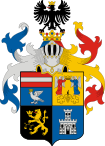Bodrogkeresztúr
You can help expand this article with text translated from the corresponding article in Hungarian. (May 2016) Click [show] for important translation instructions.
|
Bodrogkeresztúr
Kerestir or קערעסטיר | |
|---|---|
Municipality | |
 View of Bodrogkeresztúr | |
| Coordinates: 48°9′37″N 21°21′35″E / 48.16028°N 21.35972°E | |
| Country | |
| Region | Northern Hungary |
| County | Borsod-Abaúj-Zemplén |
| Processus | Tokaji járás |
| Government | |
| • Mayor | Májer József |
| Area | |
• Total | 29.87 km2 (11.53 sq mi) |
| Population (2015) | |
• Total | 1,109 |
| • Density | 37.96/km2 (98.3/sq mi) |
| Time zone | UTC+1 (CET) |
| • Summer (DST) | UTC+2 (CEST) |
| Postal code | 3916 |
| Area code | 47 |
Bodrogkeresztúr (shortly, "Keresztúr", Yiddish: קערעסטיר) is a village in Borsod-Abaúj-Zemplén county, in the Tokaj District, Hungary.
Before World War II, there was a sizable Jewish community in Bodrogkeresztúr. At its height, there were 535 Jews in the community, but most of them were murdered by the Nazis during the Holocaust in Hungary.[1][2]
Rabbi Yeshaya Steiner of the Kerestir Hasidic dynasty lived Bodrogkeresztúr at 67 Kossuth Utca.[3] The house still serves tens of thousands of people annually, especially on the anniversary of his death.[4][5]
History
[edit]The area has been inhabited since prehistoric times, evidenced by significant Neolithic finds, including gold jewellery from 1200 BCE known as the "Treasure of Dereszla."
The exact origin of the village's name is unknown; it may have been named after crusader knights. The settlement and its fortress were first mentioned in 1239, likely destroyed during the Mongol invasion. From 1411, the village became part of the Tokaj estate. By the 16th century, it was mentioned as a market town, and from the end of that century until the mid-17th century, a printing press operated there.
The Rákóczi's War of Independence took a toll on the village, but it managed to recover, mainly due to viticulture, modernized significantly by Hasidic Jewish settlers who arrived in 1726.[6] During the 1848–49 War of Independence, the settlement was looted. A prominent member of the Jewish community was Rabbi Yeshaya Steiner (1851–1925), a revered rabbi who passed away in Bodrogkeresztúr in 1925. His former residence is now a memorial house and pilgrimage site.
Gallery
[edit]

References
[edit]- ^ The census of Jews in Hungary
- ^ Bodrogkeresztúr, Hungary at JewishGen
- ^ "Official registration of company managing it". Retrieved 2024-10-26.
- ^ "Reb Shayele Kerestirer | Yahrzeit". www.ravlehoishia.org. Retrieved 2024-10-26.
- ^ Viktor, Cseh (2024-05-09). "Reb Sájele, akit a béke vezérelt Bodrogkeresztúrra". Zsido.com (in Hungarian). Retrieved 2024-10-26.
- ^ "www.vendegvaro.hu". Archived from the original on 2010-07-20. Retrieved 2011-06-15.
External links
[edit]- Street map (in Hungarian)
- Bodrogkeresztúr, Hungary - JewishGen KehilaLinks
- Bodrogkeresztúr - Footsteps of the wonder rabbis (in Hungarian)




